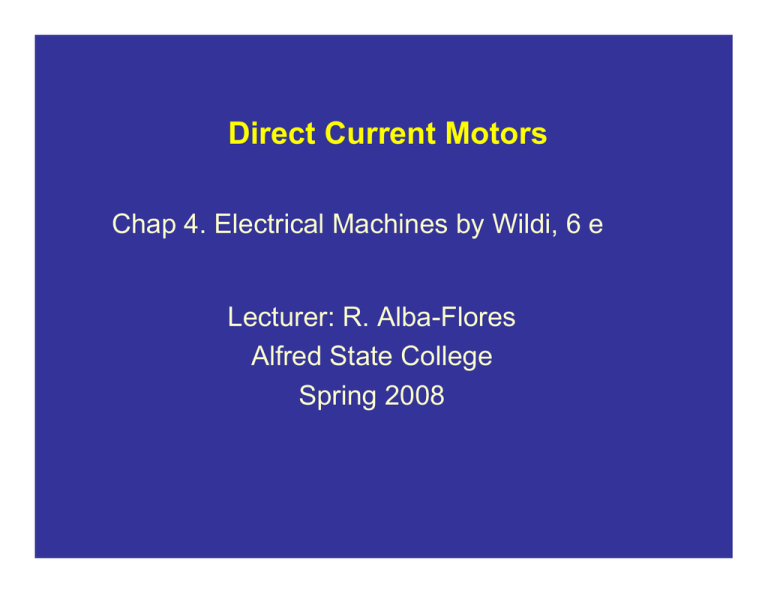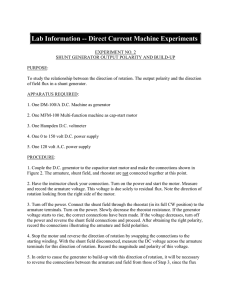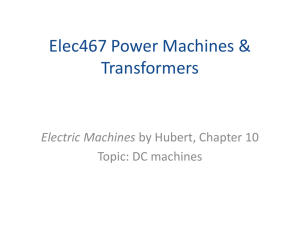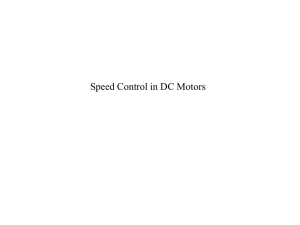Direct Current Motors Chap 4. Electrical Machines by Wildi, 6 e
advertisement

Direct Current Motors
Chap 4. Electrical Machines by Wildi, 6 e
Lecturer: R. Alba-Flores
Alfred State College
Spring 2008
Single Phase Generator
Two-phase generator
Three-phase generator:
Generating an AC voltage
A simple AC generator with a coil that rotates at 60 rev/min between
the N and S poles of a permanent magnet is:
• The coil is connected to two slip rings mounted on the shaft.
• The slip rings are connected to an external load by means of two
stationary brushes x and y
• As the coil rotates, a voltage in induced between its terminals A and D
[ E = Blv (B flux density, l length of the conductor, v, speed of rotation) ]
• This voltage appears between the brushes, and therefore across the load
• The voltage is maximum when the coil is in its horizontal position
• The induced voltage is minimum when the coil is in its vertical position
• The coil polarity changes every time the coil makes half a turn
Direct-Current Generator
If the brushes x and y could be switched from one slip ring to the other
every time the polarity is about to change, we could obtain a voltage of
constant polarity across the load.
Brush x could be always positive, and brush y negative
This can be obtained by using a commutator
A very simple commutator is a slip ring that is cut in half
- One segment is connected to coil-end A
- The other segment is connected to coil-end D
- The commutator revolves with the coil and the voltage between
the segments is pickup by two stationary brushes x and y
The voltage between brushes x and y
pulsates but never changes polarity.
Pulsating DC voltage
Improving the Pulsating DC voltage
By increasing the number of coils and segments we can obtain
a smoother DC voltage.
• The coils are held in slots of a laminated iron cylinder.
• The coils and the cylinder are the armature of the machine.
This armature has 4 slots, 4 coils, and 4 commutator bars
Generator with an armature that has 4 slots, 4 coils and 4 commutator bars
Physical construction
Smoother induced DC voltage
Schematic diagram
Armature has rotated 45 o
Exy = eb + ec = ea + ed
Schematic diagram of the armature and the voltages induced in
a 12 coils, 12 slots, and 12 commutator bars
Small permanent magnet machine
Small wound–field machine
(GEC Small Machines Ltd.)
In practical armature windings the coils and
commutator segments are interconnected so that
the conductors carry current all the time, and there
are usually several coils in series between the
brushes as shown in the previous figure (Small
wound–field machine, GEC Small Machines Ltd.)
DC machine action in terms of magnetic forces
Armature reaction
A current ia flowing in the armature will produce a flux φa at right
angles to φ
φa this is known as the armature reaction flux
DC machine action in terms of magnetic forces
The existence of an armature reaction flux, φa, implies
magnetization of the armature iron, which maybe
represented by N and S poles.
Form the Maxwell stress concept it follows that there
will be a torque on the armature tending to rotate its
poles into alignment with the field poles.
The armature winding and commutator, ensure that the
magnetic axis of the armature remains fixed in space
while the armature material revolves.
Therefore a steady torque is developed, which is
unaffected by the rotation of the armature.
DC machine action in terms of magnetic forces
The armature and field circuits
In permanent–magnet machine the field flux φ is constant.
In wound-field machines, the pole flux φ depends on the field or
excitation voltage Vf
The current if flowing in the field winding will produce a pole flux φ.
With no armature current flowing, φ will be a function of if only
At constant speed ea is proportional to φ
Magnetization curve or open-circuit
characteristic
Wound-field DC machine
Armature magnetomotive force (mmf) ( armature reaction )
{ magnetomotive force or magnetic potential analog to
electromotive force (emf) or voltage }
Magnetic field produced by the current
flowing in the armature conductors
Armature reaction distorts the field
produced by the N-S poles
Commutating poles produces a mmfc that opposes the mmfa
of the armature
Separately excited generator
• Separately excited 2-pole generator.
• The N-S field poles are created by the current
flowing in the field windings
Separately excited DC generator curves
Flux per pole versus exciting current
The rated voltage of a DC
generator is usually a little
above the knee of the
saturation curve
Saturation curve of a DC generator
Self-excited shunt generator
Shunt
field
A shunt field is connected in parallel with the armature winding
• When a shunt generator is started up, a small voltage is induced in the
armature, due to the remanent flux in the poles.
• This voltage produces a small exciting current Ix in the shunt field.
• The resulting small magnetomotive force (mmf) acts on the same
direction as the remanent flux, increasing it.
• This will increase Eo and also Ix, increasing even more Eo
Controlling the voltage of a shunt generator
• Controlling the generator induced voltage can be done by varying the
exciting current by means of rheostat connected in series with the shunt
field.
• A rheostat is a resistor with an adjustable sliding contact.
No-load value of the induced voltage Eo
Knowing the saturation curve of the generator and the total resistance Rt of the
shunt field circuit the no-load voltage can be determined.
If Rt continue to increase, a critical value will be reached, and after this no
induced voltage will be generated.
Equivalent circuit of a DC generator
• The armature winding contains a set of identical coils, all of which possess
a certain resistance.
• The total armature resistance, Ro, is the one that exists when the
machine is stationary.
• Ro is usually very small < 0.01 ohms
Separately excited generator under load.
Compound generator under load
Typical load characteristics of DC generators
Circuit representation of series,
shunt, and compound DC
machines and their torque vs
speed characteristic.








